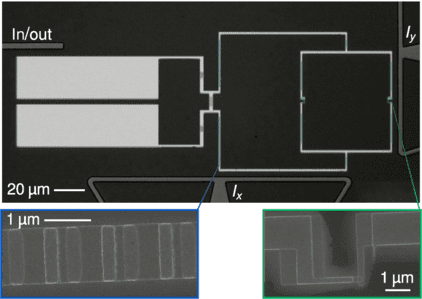A research team at the Laboratoire de Physique de l’Ecole Normale Supérieure (LPENS) in France has developed a new way to protect superconducting quantum bits (qubits) from noise. Thanks to a novel superconducting circuit element that effectively “spreads out” the qubit’s quantum state, the team reduced the qubit’s sensitivity to an external magnetic flux by a factor of 10. This improvement could lead to the development of next-generation superconducting qubits that are less prone to errors.
Quantum information stored in qubits is fragile to noise from the surrounding environment, and this remains a major challenge for building large-scale quantum computers. One prominent approach to protecting qubits from noise is to delocalize their quantum information: because noise is typically local, quantum information that is stored non-locally is less likely to be spoiled. For example, certain types of quantum error correction encode information in a network of many spatially separated qubits.
Interestingly, this delocalization approach can also be applied to a more abstract form of space known as the Hilbert space of a qubit. One popular example is the superconducting transmon qubit, the states of which are greatly spread over many charge values, providing some immunity against charge noise.
Cooper-pair pairing
The quantum states of a superconducting circuit can be described in terms of paired electrons known as Cooper pairs (the primary charge carrier in superconductors) or the superconducting phase (technically, the phase of the complex superconducting order parameter). When individual Cooper pairs tunnel across a so-called Josephson junction, which commonly consists of two superconductors sandwiching a thin insulator, the current flowing through the junction depends nonlinearly on its superconducting phase. This phenomenon, termed the Josephson effect, is a key element in almost all superconducting qubits.
The LPENS researchers designed a new superconducting qubit in which the quantum states are delocalized over a wide range of values of the superconducting phase. They achieved this by creating a generalized version of a Josephson junction in which two Cooper pairs tunnel through the junction simultaneously – that is, a pairing of Cooper pairs.
The new junction was realized in a superconducting loop interrupted by two Josephson junctions and two superinductors, which are large inductors with small accompanying capacitances. This arrangement, which the team dubs a kinetic interference co-tunnelling element (KITE), was inspired by a 20-year-old proposal that suggests observing the Cooper-pair-pairing effect in a superconducting loop of four Josephson junctions. “The difference is that the KITE trades two of those junctions for superinductors, which gives better resilience to offset charge noise and some other desirable properties,” says Clarke Smith, the lead author of a Physical Review X paper describing the research.
The team carefully controlled the KITE loop by using destructive interference to suppress the tunnelling of single Cooper pairs over the two Josephson junctions, allowing co-tunnelling of two Cooper pairs to dominate. This magnifies the fluctuations of the superconducting phase by more than a factor of two – a considerable increase in the spreading of the qubit states. The team then observed experimentally a 10-fold reduction in the qubit’s sensitivity to an external magnetic flux, rendering it more resilient to flux noise.

Superconductor reveals new state of matter involving pairs of Cooper pairs
Towards protected superconducting qubits
The researchers say that their generalized Josephson junction is a vital circuit element in making superconducting qubits that are intrinsically resilient to noise. By combining such a junction with another element known as quantum phase-slip, it might become possible to implement a so-called Gottesman-Kitaev-Preskill qubit in which qubit states are delocalized over both the charge and phase spaces and thus even more robust against noise. According to Smith, one follow-up project would be to develop effective quantum phase-slip junctions and build qubits that are intrinsically protected from noise without resorting to quantum error correction. Such qubits would significantly ease the hardware complexity required to build a fault-tolerant quantum computer.
